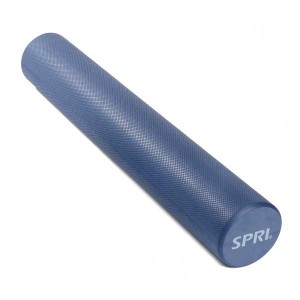
You’ve had a great workout. You really killed it this time. And, inevitably, your muscles start hurting like crazy. Now – this is good. Muscle growth doesn’t happen while you’re working out. When you push yourself in your workouts, you create micro-tears in your muscles, and during your recovery after your workout, those tears heal. That healing process bulids extra muscle tissue – that’s where your muscle growth and strength increases come from. The only downside of all of this is muscle soreness. By incorporating an foam roller into your fitness regime, you can aid in your muscle recovery, while also getting rid of some of that soreness!
What is self-myofascial release?
Self-myofascial release is a fancy term for self-massage to release muscle tightness or trigger points. Self-myofascial release, also known as “foam rolling,” has gone from being a mysterious technique used only by professional athletes, coaches, and therapists, to a familiar everyday practice for people at all levels of fitness. Recent information, technology, and affordable products have introduced an increasing array of training and recovery methods to the average person.
Self-myofascial release can be performed best with a foam roller. By applying pressure to specific trigger points on your body you are able to aid in the recovery of muscles and help return them to normal function. Normal function means your muscles are elastic, healthy, and ready to perform at a moment’s notice.
What are trigger points?
Trigger points are specific “knots” that form in muscle, and can most easily be described as the pain felt when pressure is applied to one area of the muscle, but the pain is felt or radiated in another area. When rolling or working on tight/sore muscles you will experience discomfort or pain. Think of it like the pain you get while stretching. It should be uncomfortable, but not unbearable, and when you are done it should feel better.
How do you do foam rolling?
Foam rolling can help to break up these muscle knots, resuming normal blood flow and function. To foam roll properly, apply moderate pressure to a specific muscle or muscle group using the roller and your bodyweight. Roll slowly, at a rate of no more than one inch per second. If you find areas that are tight or painful, pause for several seconds and relax as much as possible, then continiue.
If an area is too painful to apply direct pressure, shift the roller and apply pressure on the surrounding area and gradually work to loosen the entire area. The goal is to restore healthy muscles – it is not a pain tolerance test. And, never roll a joint, bone, or your lower back.
And, if you’re looking for a foam roller, stop into one of Fitness 4 Home Superstore’s 3 Valley locations today! We carry a full range of fitness accessories, including foam rollers and other workout recovery accessories.

